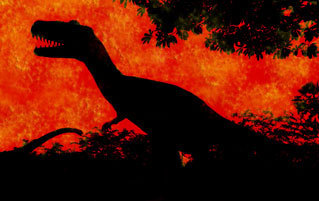6 Dinosaurs We Just Found Out Had X-Men Powers

There are a handful of things you learn as a child that hold true all the way through adulthood: stoves are hot, you cannot ride the dog, and dinosaurs are awesome. Those are the only facts in life; everything else is subjective. But recent discoveries are shedding some shocking new light on our planet's resident badasses. Your heart fell a bit reading that, but don't worry -- we're learning that, if anything, dinosaurs may have been way cooler than we ever thought possible.
Tyrannosaurus' Cute Little Arms Could Rip You to Shreds

Tyrannosaurus rex was the Tyrannosaurus rex of the dinosaur world. You don't need metaphors when you've got a bite force in excess of the weight of an African elephant. A single nibble from T. rex makes your whole goddamn species go extinct. The only thing powerful enough to kill and eat a T. rex is another T. rex. Still, there's one thing that made every T. rex grow up to develop a nagging inferiority complex, and that's the relentless teasing all the other dinosaurs gave him about his itty-bitty arms.

"Dude, it's how you use it."
Hey, you guys, T. rex is napping -- quick, tickle his ear hole and let's watch him try to slap it! And then we'd laugh and laugh, and he'd use those hilariously inadequate arms to rip us clean the fuck in two.
Though they were only slightly longer than an average man's, you've got to remember that a T. rex's arms were attached to nine salivating tons of pure, fabulous muscle. His biceps alone could curl 430 pounds apiece, and that's not even taking into account the fact that those guns had backup in the form of the friggin' nuclear weapons that were his chest and shoulder muscles. Paleontologists think that a T. rex's arms were powerful enough to help him push his enormous body up from the ground after sleeping, or to latch onto a female T. rex during mating. If they're strong enough to bone a T. rex with, those arms are more than strong enough to rip you apart like so much meaty Weetabix.

In case he gets bored of eating you whole and decides to make kebabs instead.
Sauropods Could Bring the Thunder (Literally)

The apatosaurus was basically a slow-moving magnitude-4 earthquake. Paleontologist Philip Currie teamed up with Microsoft computer wizard Nathan Myrhvold to create a computer model of a living one, and together they found that the dinosaur's extremely long, tapered tail could be whipped at supersonic speeds -- a theory bolstered by the fact that the apatosaurus fossils they examined had an area of fused vertebrae near the end of the tail, indicating repeated stress. What does all this mean? Well, have you ever gone to a circus and seen a performer put on a show with a bullwhip? And do you remember the loud crack the whip made when snapped? That's because the loop of the whip breaks the sound barrier and produces a miniature sonic boom. Now, take that crack and amplify it by a factor of apatosaurus.

This basically entails hitting multiply over and over until the calculator breaks.
Of course, other paleontologists say the bullwhip theory is a bunch of bunk, and to those paleontologists we say, "Shhh, it's better this way. Some truths are not meant for man."
But just in case they're right, we feel obligated to supply you with equally awesome backup information: Brontomerus, rather cruelly translated to "thunder thighs," is a species of sauropod recently discovered in Utah. It had a massive bone in the upper part of its hip, and where there's a massive bone, there are also massive muscles attached to it. If apatosaurus was the dinosaurs' answer to Indy, brontomerus was their Pele: While most sauropods looked like defenseless walking buffets of exposed neck meat, scientists believe that if you were to call a brontomerus "thunder thighs" to its face, you could have found yourself on the receiving end of a full-bore dinosaur punt, pictured here, in the single best paleontological rendering ever commissioned.

"I SAID I'M SENSITIVE ABOUT MY FIGURE!!"
Crested Dinosaurs Were Musical
We've always dreamed that dinosaurs spoke in either blood-splintering roars or prim-and-proper British accents (our dreams are weird), but medical scans of fossil skulls have shown that parasaurolophus and its relatives had a more sophisticated repertoire. The bony crest on this hadrosaur's head formed a long resonating tube that connected to the nasal cavity -- kind of like a built-in didgeridoo that sounded off with a deep, somber note whenever the animal blew its nose. A team of researchers recreated the sweet dino-song of parasaurolophus via computer simulation:
The skull scans also showed that these bands of musical dinosaurs probably had the brainpower necessary to use these calls for communication (for mating, of course). We'll never know how advanced their musical talents might have been, but we're going to go out on a limb here and speculate that some lucky lady parasaurolophus was once serenaded by the fiercest saxophone solo this side of George Michael's Careless Whisper.
"Velociraptors" Could Hunt Your Ass Down in the Dark

While Jurassic Park took some undeniable liberties with velociraptors (like calling them "velociraptors," for one -- deinonychus was the actual dino upon which the movie's velociraptors were based), it got at least one thing right: Paleontologist John Ostrom agrees that deinonychus were indeed pack hunters. It's probably also true that you'd never even see their attacks coming until you found yourself in dire need of a spare liver, not because they used distraction tactics like in the movie, but because they could totally see in the dark. Yep, probably the only thing worse than having a vicious pack of snarling raptors coming to feast upon your sweetbreads is having a vicious pack of snarling raptors coming to feast upon your sweetbreads in the pitch black of night.

At least you don't have to watch.
Dinosaurs, lizards, and birds all have bony rings in their eyes that we mammals lack, and by comparing the dimensions of the ones in deinonychus' and other raptors' eyes with those of today's animals, researchers were able to determine that they were a bunch of prehistoric Sam Fishers.

The fossilized black mesh suit may have tipped them off as well.
But raptors weren't the only ones stalking the Mesozoic by moonlight -- other predators had night vision, too, like the troodon, which evolved super-wide eyes in order to see in the dark of a polar winter. Oh, that reminds us! We almost forgot to mention that ...
Dinosaurs Could Survive a Polar Winter

Even though many researchers agree that at least some dinosaurs were warm-blooded, most of us still imagine them living exclusively in swamps and deserts and tropical island theme parks. After all, everybody knows it was an ice age that killed them off for good.

They had to die so that Ray Romano's career could continue to live.
But think about that for a second. Dinosaurs ruled the Earth for 180 million years, which is nearly three times as long as we puny mammals have reigned since. So it's hard to believe that there was any environment on Earth that they couldn't eventually adapt to. And indeed, a little bit of nippy air wasn't about to stop the dinosaurs: Back in the day, Alaska was positively crawling with troodon, as well as larger predators like nanuqsaurus, T. rex's smaller parka-wearing cousin from the north, whose name means "polar bear lizard."

Fur is murderer.
Grazing herds of large plant-eaters are also thought to have settled up north year-round. During the Reign of the Ice Dinosaurs (dibs on the Syfy original movie title), the Alaskan landmass wasn't as cold as its modern-day counterpart, but these dinosaurs still would've endured three whole months of snow and ice. It seems that, just like mammals, dinosaurs were adaptable enough to live anywhere they damn well pleased. And if they decided that the whole world was getting a bit too chilly for their liking, well, that's nothing a gargantuan monster-fart can't fix.
W-what?
Dinosaurs Farts Could Change a Planet

The dinosaurs were literal badasses.
Some scientists now believe that the dinosaurs dominated the environment using only their weapons-grade farts. You see, big sauropods like apatosaurus spent their entire waking lives horking down tons of plants, and thoroughly chewing all that food would have taken more hours in a day than there actually were. If they didn't have stomach stones to grind all that matter up, it stands to reason that gut bacteria would have stepped in to fill that role -- and gut bacteria produce a lot of globe-warming methane.

There's a reason those pterodactyls are flying away.
A team of researchers led by David Wilkinson compared the stink-to-body-mass ratios of today's animals with the size of dinosaurs and estimated that sauropods alone pumped 520 million tons of methane into the Jurassic atmosphere per year. Just for reference, that's roughly the same amount as every single methane source on the planet today -- including artificial emissions from human activity -- all coming from just one group of reptilian buttholes.

Whoever drew that last bar in brown is our kind of scientist.
During the Jurassic period, volcanoes were blowing up all willy-nilly, and rising carbon levels made things hotter, wetter, and overall more plant-friendly. More abundant plants led to bigger, hungrier dinosaurs, whose gargantuan gastric systems spewed even more greenhouse gas into the atmosphere, allowing even more plants to thrive. That's right: The dinosaurs terraformed a whole planet with farts.
When Mr. Yee isn't checking his closet for velociraptors hiding in the dark, he's probably writing his fortune cookie of the day and trying to get somebody to buy his T-shirts.
Related Reading: Hey, did you know some crazy people have written dinosaur erotica? We've covered the shit out of that. We've also revealed some truly bizarre dinosaurs you won't believe existed. And if you're interested in some wild scenes preserved by fossils, we've got you covered.
And to further straighten out your noggin, check out Cracked's De-Textbook: The Stuff You Didn't Know About the Stuff You Thought You Knew.


